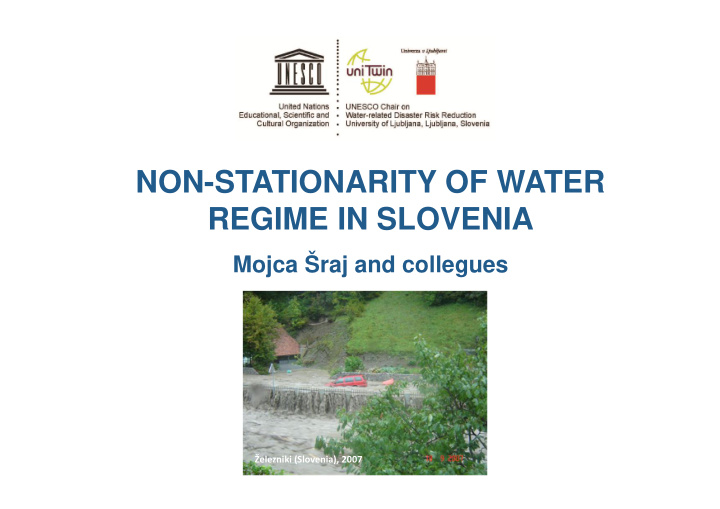



NON-STATIONARITY OF WATER REGIME IN SLOVENIA Mojca Šraj and collegues Železniki (Slovenia), 2007
Introduction • Climate variability is both an important environmental subject and a significant political issue. • The global mean surface air temperature have increased significantly in the past decades (Jones et al., 1999; Pachauri et al., 2014). However, the magnitudes differ amoung regions. • Similarly, researchers found significant changes in precipitation that differ amoung regions. • However, increasing or decreasing temperature or precipitation trends are not necessarily associated with the corresponding trends of high flows. • Consequently, no uniform pattern has been found for (flood) discharge series around the globe (e.g.Robson et al. 1998; Douglas et al. 2000; Zhang et al. 2001; Kundzewicz et al. 2005; Bezak et al., 2014) 2
Precipitation trends in Slovenia Increasing trend Decreasing trend No significant trend ZIMA JESEN AUTUMN WINTER POMLAD POLETJE SPRING SUMMER Kobold et al., 2012 3
Extreme flood events in Slovenia • As a consequance extreme events in Slovenia have been more frequent over the last decades (Kobold et al., 2012). Floods with the the return period of at least 50 years in at least 3 watersheds 1923 1928 1933 1938 1943 1948 1953 1958 1963 1968 1973 1978 1983 1988 1993 1998 2003 2008 Kobold et al., 2012 4
Example of deviations in discharges • As an example of discharge changes Litija station on the Sava river is presented. odstopanje srednjih letnih pretokov in letnih visokovodnih konic 80 Litija - Sava 60 40 Odstopanje pretoka (%) Discharge deviation [%] 20 0 1895 1900 1905 1910 1915 1920 1925 1930 1935 1940 1945 1950 1955 1960 1965 1970 1975 1980 1985 1990 1995 2000 2005 2010 -20 -40 -60 Alpine pluvial-nival water regime Kobold in Dolinar, 2014 -80 10-years 10-years srednji letni pretok (Qs) visokovodne konice (Qvk) 10-letno drse č e popvpre č je (Qs) 10-letno drse č e popvpre č je (Qvk) Mean annual Qs Flood peaks Qvk moving average Qs moving average Qvk 5
Trends in high discharges in Slovenia • These are the facts that influence also on the accuracy of the estimated design discharges. Menih., 2014 6
Flood frequency analyses • We also investigated the influence of climate change on design discharges. • FFA were performed for different 30-years periods using the AM discharge data sets and POT samples. • Different distributions were used and parameters were estimated using the method of moments and the method of L-moments. 7
Flood frequency analyses Example of the Litija station Bezak et al., 2016 8
Differences in design discharges between two periods 54 stations 22 21 11 Menih., 2014 9
New approaches • These were the results of traditional FFA based on the assumption of stationarity; which may be questioned. • According to the presented results, it is obvious that new approches are needed considering climate change impact. • One of them is to implement time trend into the parameters of the probability distribution functions. • The problem with time varying distribution parameters is that it is difficult to justify why they would continue to change in the future exactly in the same way they did in the past. • As an alternative, models have been developed that correlate the distribution parameters to other variables such as land use or climatological variables (e.g. ENSO) 10
Šraj et al., 2016 11
Conclusions • The influence of climate change on the design discharge should be considered, but how? • Predicting the design flood for the life span of the structure in the future using time dependant non-stationary models needs to be considered with care, since it is possible that changes in the future will not be exactly the same as those in the past. • The advantage of the non-stationary model with annual precipitation as a covariate is that it avoids direct temporal extrapolation. To use this model for design purposes, reliable scenarios of future precipitation are needed. • We can conclude that improvements of FFA techniques regarding non-stationarity are still the goal for hydrologists in the near future. 12
Thank you for your attention! 13
Our recent publications about the topic • ŠRAJ, Mojca, VIGLIONE, Alberto, PARAJKA, Juraj, BLÖSCHL, Günter. The influence of non-stationarity in extreme hydrological events on flood frequency estimation. Journal of Hydrology and Hydromechanics, 2016, 64(4), 426-437, doi: 10.1515/johh-2016-0032 • BEZAK, Nejc, BRILLY, Mitja, ŠRAJ, Mojca. Flood frequency analysis, statistical trends and seasonality analyses of discharge data : a case study of the Litija station on the Sava river. Journal of flood risk management, 2016, 154-168, doi: 10.1111/jfr3.12118. • ŠRAJ, Mojca, MENIH, Matevž, BEZAK, Nejc. Climate variability impact assessment on the flood risk in Slovenia. Physical geography , 2016, 37(1), 73-87, doi: 10.1080/02723646.2016.1155389. • ŠRAJ, Mojca, BEZAK, Nejc, BRILLY, Mitja. Bivariate flood frequency analysis using the copula function: a case study of the Litija station on the Sava River. Hydrological processes . In press, 2014, doi: 10.1002/hyp.10145 • BEZAK, Nejc, HORVAT, Alja, ŠRAJ, Mojca. Analysis of flood events in Slovenian streams. Journal of Hydrology and Hydromechanics , 2015, 63(2), 134-144, doi: 10.1515/johh-2015- 0014. • BRILLY, Mitja, KAV Č I Č Katarina, ŠRAJ, Mojca, RUSJAN Simon, VIDMAR, Andrej. Climate change impact on flood hazard. Evolving Water Resources Systems: Understanding, Predicting and Managing Water–Society Interactions. Proceedings of ICWRS2014, Bologna, Italy, June 2014 (IAHS Publ. 36X, 2014). • BEZAK, Nejc, BRILLY, Mitja, ŠRAJ, Mojca. Comparison between the peaks over threshold method and the annual maximum method for flood frequency analyses. Hydrological sciences journal , 59/5, 2014, 959-977, doi: 10.1080/02626667.2013.831174. 14
Recommend
More recommend